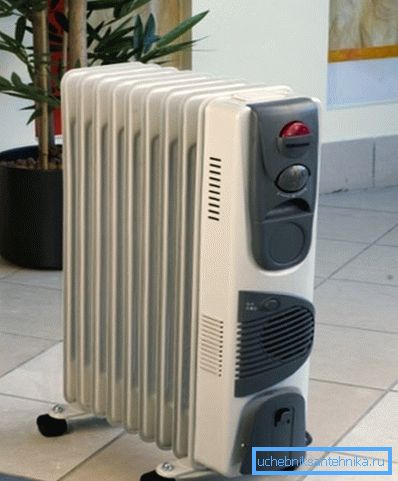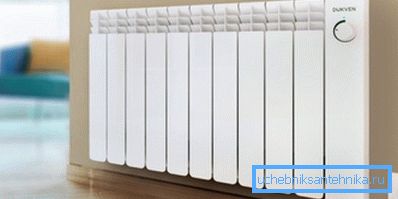Radiator heater. features of oil devices. the device, the
The radiator oil heater is the most common household appliance today, designed for additional space heating. The high popularity of the device due to the mass of the advantages and safety of its work. We want to consider the features that differ oil heaters, heaters.

Oil heater
Device

The electric heater on mineral oil is arranged rather simply. Consider the main elements of its design:
| Construction site | Purpose and device |
| Mineral oil tank | Provides natural circulation of heated oil and the transfer of its thermal energy to the body. The body often has the shape of a sectional harmonica, but also meets the panel type |
| Tubular heating element | It is a metal spiral with a certain resistance, which is hidden in a tube with a powder filler. When an electric current flows in a spiral, it heats up and transfers heat to the filler and to the tube body, which in turn heats the oil. |
| Thermostat | Designed to automatically control the heating temperature of the device. It can react to air temperature or to the performance of the apparatus. As a rule, it works on a bimetallic plate and opens the supply circuit of the heating element when the temperature rises above the set limit, and also closes it back when the temperature drops below a certain level |
| Power controller | This node is designed to control the operating current in the heating element. It can provide smooth adjustment or switch between a number of operating modes. Allows you to use the device in conditions with different loads |
| Safety valve | In the event of overheating of the oil or for other reasons, the pressure inside the housing can increase greatly. If it exceeds a certain limit, then the safety valve opens and prevents the destruction of the body of the product, which is fraught with explosion and fire. |
| Thermal fuse | In case of a thermostat malfunction, a fuse is provided in the design, which is installed near the heating element inside the case and turns off its power supply when overheated |
| Electronic timer | Allows you to set a convenient mode of operation and determine the schedule for switching on and off the convector. Not installed on all models |

In addition to the basic units listed in the table, the design may include additional elements:
- fan for blowing the body, which increases the efficiency of the device and the rate of heating of the room;
- a humidifier that helps normalize humidity in the room;
- watch face;
- special frame for drying clothes.

Note! Sectional housing is a solid monolithic product and does not disassemble. Attempts to disassemble the device into sections or open its case with their own hands are fraught with irreversible damage.
Operating principle

To better understand the principle of operation of the device, we should recall some points from the physics course.
Man knows two ways of direct transfer of thermal energy:
- The emission of light in the infrared. In this way we get heat from the sun or from a fire in the fireplace. It spreads instantly, more precisely at the speed of light, so the effect is immediately noticeable;
- Direct heat transfer. Faster atoms and molecules of the heated substance bombard the particles of a cold body and accelerate them, thereby increasing the temperature of the substance-donor of thermal energy. To ensure the presence of this effect is enough to touch your own forehead.

An additional factor in the distribution of heat, which plays a significant role in the work of convectors, is the effect of convection of liquids and gases. It consists in the fact that, with uneven heating of the medium in the field of a cold, layers with a higher temperature and a lower density begin to float, while less heated layers, on the contrary, sink.
Since the heating element is installed in the lower part of the tank with oil, the heated mass of the coolant floats up, and its place is taken by the cooled layer. Thus, heat is transferred from the heating element to the heater body.
In addition, the device itself is installed on the floor and is in contact with the coldest mass of air. When this mass is heated, it rises to the ceiling, and a new portion of gas takes its place. So natural convection helps to distribute heat indoors.

Consider the work of the radiator in stages:
- Power is supplied to the heater, which begins to heat up. The degree of heating is controlled by a thermostat and a thermal fuse;
- The oil inside the body begins to heat up, layers with different densities are mixed, heat is transferred to the body of the product;
- The body begins to emit infrared light that is invisible to our eyes, which transfers heat. The share of heat transfer, which accounts for radiation, is 50 - 60%;
- The air in contact with the housing starts to heat up. Its density decreases, and the gas begins to be pushed up by more dense masses, which take its place and also heat up. Circulation of heated air occurs;
- As a result of radiation, direct heat transfer and convection, the air in the room is heated. The thermostat records the achievement of a certain temperature set by the operator in advance and turns off the power supply to the heating element;
- When the device is turned off, the air in the room cools down. The thermostat cools down with the air, and at some point turns on the heating element again. The process is repeated.

Note! For normal operation, the heating radiator must be in a vertical position. Otherwise, the heating element can be in the air bubble and quickly burn out.
Advantages and disadvantages

The idea to make an electric heater out of a radiator turned out to be successful and fully justified in practice. The result is a compact, convenient and safe device that successfully copes with the tasks assigned to it.
Consider the main advantages characteristic of oil convectors heating:
- High security. It is caused by the fact that all high-temperature elements are hidden in a hermetic case, and the use of an intermediate heat carrier, whose role is played by oil, allows the body to be heated to temperatures safe for humans - 60 - 95? С;
- High level of control. The use of a thermostatic regulator and automatic control systems makes the device autonomous. The presence of thermal and electronic fuses makes the work of the product controlled and safe;
- Durability and Continuity. A simple and reliable scheme allows the device to operate in continuous load mode for a long period of time, and the design of the elements and details of the design makes this work reliable and uninterrupted;
- Affordable price. Like most other household appliances, oil heaters have become available to almost any consumer. You can find models in a variety of price ranges;
- Low temperature operation and relatively weak heating of the case allow the device not to overdry the air in the room, not to produce a burning smell and not to burn small particles and dust. The heat emanating from the hull is reminiscent of natural chimney heat;
- No noise during operation It is also a clear advantage of the device, which distinguishes it favorably from fan heaters and heat guns.

Features like compactness, mobility, and ease of operation and maintenance can be added to this list. The maximum that the instruction will require of you is to set the mode of operation and sometimes wipe the case with a damp cloth.
If we talk about the shortcomings, we can highlight the following points:
- Large enough weight. If the product can be moved around the room with the help of roller bearings, then transportation over long distances will require the use of transport;
- Large thermal inertia. Heat or cool the surface of the case too quickly will not work, it takes time;
- Long term warming up of the room. Unlike a fan heater or a heat gun, it will take at least half an hour to heat a room.

Note! In summary, we have a safe, reliable and durable heater with an affordable price and efficient operation.
Species

On the market there are different in design, function, application and installation method of the battery with oil. The most significant differences relate to the shape of the body. It can be in the form of a panel or accordion.
Panel models are less common, as they are less effective due to the reduced heat transfer area. At the same time they are easier to mount on the wall, and they take up less space in the room.

According to the type of installation, wall, floor, table devices and models for cots are distinguished. The most popular and widely used floor structures with roller supports for easy movement around the apartment.
The principle of operation and the device of various types do not differ fundamentally, and the present differences relate to trifles: the parameters of power and heat transfer, the shape of the case, the presence of additional functions. The most functional, again, floor models.

Note! When choosing a particular model, pay attention to the power, security system and reputation of the manufacturer.
Conclusion
An electric heater for space heating based on mineral oil is a reliable, safe and convenient household appliance. Efficiency and affordable cost made this type of radiator the most popular. The video in this article will be able to answer any questions that may arise.